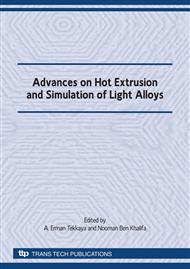[1]
O. Richmond, M.L. Devenpick: A Die Profile for maximum efficiency in strip drawing. Proc. 4th U.S. Congr. Appl. Mech., ASME (1962), p.1053.
Google Scholar
[2]
O. Richmond, H.L. Morrison: Streamlined wire drawing dies of minimum length. Journal of Mech. Phy. Solids Vol. 15 (1967), p.195.
DOI: 10.1016/0022-5096(67)90032-4
Google Scholar
[3]
S.K. Samanta: Slipline field for extrusion through cosine shaped dies. Journal of Mech. Phy. Solids Vol. 18 (1970), p.311.
DOI: 10.1016/0022-5096(70)90001-3
Google Scholar
[4]
C. T. Chen, F. F. Ling: Upper bound solutions to axisymmetric extrusion problems. Int. Journal of Mechanical Science Vol. 10 (1970), p.311.
Google Scholar
[5]
K. T. Chang, J.C. Choi: Upper bound solutions to axisymmetric extrusion problems through curve die. Proc. the 12th Midwestern Mech. Conf. Univ of Notre dame (1971).
Google Scholar
[6]
E. Meta-Pietri, J. Friach: Metal flow through various mathematically contoured extrusion dies. Proceedings, North Amer. Metal-working Research Conf. Vol. 5 (1977).
Google Scholar
[7]
J. Friach, E. Mata-Pietric: Experiments and the upper bound solution in axisymmetric extrusion. Proc. IMTDR conference Vol. 18 (1977), p.55.
Google Scholar
[8]
K.P. Maity, P. K. Kar and N.S. Das: A class of Upper-bound Solutions for the extrusion of square shapes from square billets through curved dies. Jourrnal of Materials Processing Technology Vol. 62 (1996), pp.185-190.
DOI: 10.1016/0924-0136(95)02228-7
Google Scholar
[9]
R. Narayanasamy, R. Ponalagusamy, R. Venkatesan and P. Srinivasan: An Upper Bound Solution to Extrusion of Circular Billet to Circular Shape through cosine dies. Journal of Material and Design Vol. 27 (2006), pp.411-415.
DOI: 10.1016/j.matdes.2004.11.026
Google Scholar
[10]
S.K. Lee, D. C. Ko and B.M. Kim: Optimal die profile design for uniform microstructure in hot extruded product. International Journal of Machine Tools & Manufacture Vol. 40 (2000), pp.1457-1478.
DOI: 10.1016/s0890-6955(00)00008-0
Google Scholar
[11]
T. Reinikainen, K. Andersson, S. Kivivuori and A. S. Korhonen: Finite-element analysis of copper extrusion processes. Journal of Materials Processing Technology Vol. 34 (1992), pp.101-108.
DOI: 10.1016/0924-0136(92)90095-a
Google Scholar
[12]
J. L. Kuester, J. H. Mize: Optimization Techniques with Fortran. McGraw Hill Book Company.
Google Scholar
[13]
C.S. Yih: Stream Functions in Three-Dimensional Flow. La Haulle Blanche Vol. 12 (1957), p.445.
Google Scholar


